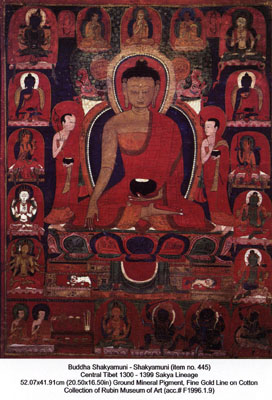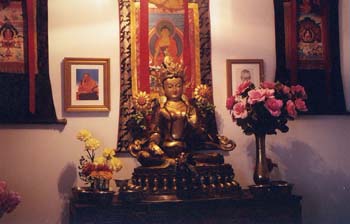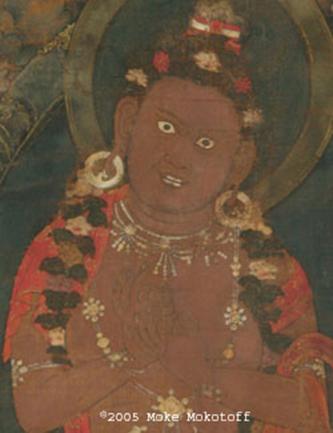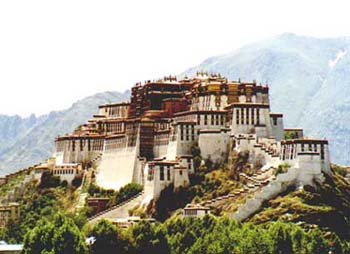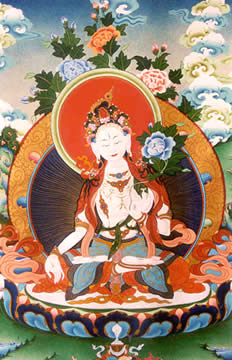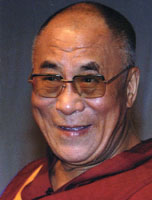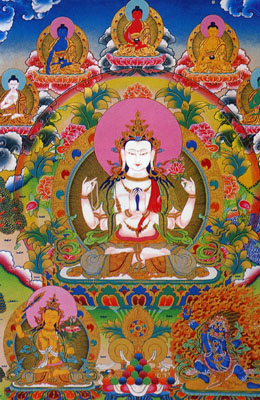
Heidi Kaiter
Concord Middle School, Concord, MA
~Buddhism by Numbers~
|
Note: Buddhist Dharma concepts are often arranged in concise lists. The following is provided as a reference guide of Buddhist terminology.
~1~ 1 Fundamental Principle: All sentient beings wish to be free of suffering. The root cause of suffering is ignorance (self-grasping and self-cherishing mind). We are 1: Visit: Global Village. ~2~ 2 Accumulations: Merit and Wisdom. 2 (Dualistic Principles): Sun & Moon, Ego & Selflessness, Light & Dark, Male & Female, Outer & Inner, Visit: Yin and Yang. 2 Extremes to Avoid: Samsara and Nirvana. 2 Truths: Conventional Truth and Ultimate Truth. 2 Types of Meditation: Calm-abiding / Single-pointed Placement (shamatha) and Special Insight / Analytical Contemplation (vipassana). 2 Phases of Tonglen Practice: Taking and Giving. 2 Stages of Diety Visualization: Generation and Completion. 2 Nirvanas: Pratisamkhanirodha (extinction of past defilements), Apratisamkhanirodha (non-arising of future defilements). 2 Bodhicittas: (wishing and entering) or (relative and ultimate). 2 Hinayana Practitioners: Hearer (sravaka) and Solitary Realizer (pratyekabuddha). 2 Kayas: Rupakaya (form body) and Dharmakaya (truth body). ~3~ 3 Jewels (Triple Gem): Buddha, Dharma, Sangha. 3 Visions: Impure Vision, Vision of Experience, Pure Vision. 3 Sufferings: Suffering of Suffering, Suffering of Change, Suffering of Conditioned Phenomenon. 3 Poisons: Ignorance (pig), Anger / Aversion (snake), Desire / Attachment (cockerel). 3 Antidotes to Poisons: Wisdom, Meditation, Discipline. 3 Pitakas / Baskets: Abhidharma (wisdom: antidote to ignorance), Sutrayana (meditation: antidote to anger), Vinaya (discipline: antidote to desire). 3 Principal Aspects of the Path: Renunciation, Bodhicitta, Emptiness. 3 Realms of Samsara: Desire, Form (meditative concentration), Formless (meditative absorption). 3 Faiths: Blind Faith, Desiring Faith, Unshakable Faith. 3 Vows: Hinayana (Pratimoksha Vow), Mahayana (Bodhisattva Vow), Vajrayana (Samaya). 3 Bodhisattva Vow Methods: Shepherd, Sailor, King. 3 Dharma Kings of Tibet: Songtsen Gampo, Trisong Detsen, Tri Ralpachen. 3 Pots: Pot with a hole, Upside-down pot, Dirty pot. 3 Doors: Body, Speech and Mind. 3 Pure Actions: Mudra (for body), Mantra (for speech), Meditation (for mind). 3 Times: Past, Present, Future. 3 Unconditioned Phenomena: Space, 2 Nirvanas. 3 Vehicles: Hinayana (Theravada: personal liberation of nirvana), Mahayana (Paramitayana: enlightenment for the sake of sentient beings), Vajrayana (Mantrayana / Adamantine / Diamond / Tantra: swift and complete enlightnement). 3 Kayas: Dharmakaya (truth body), Sambhogakaya (enjoyment form body), Nirmanakaya (emanation form body). 3 Levels of Mind: Gross Mind (with consciousness), Subtle Mind (one with which we conceive), Very Subtle Mind (true nature of mind). ~4~ 4 Noble Truths: Suffering, Origin, Cessation, Path. 4 Times: Past, Present, Future, Timeless Time. 4 Limitless Immeasurables: Love, Compassion, Joy, Equanimity. 4 Seals: All conditioned things are impermanent. All contaminated phenomena are suffering. All phenomena are empty and selfless. Nirvana is peace. 4 Universal Ages: Formation, Abiding, Destruction, Vacuity. Visit: Infinity, Cosmology. 4 Periods of Cyclic Existence: The period of life, The period of dying, The period of glimpsing the ultimate nature of the mind and its luminous visions, The bardo or transitional passage between the after-death state and the next rebirth. 4 Things Necessary for Karma to Ripen: Intention, Action, Object, Completion. 4 Sights (of Siddhartha Guatama): Sickness, Old Age, Death, Wandering Ascetic. 4 Types of Birth: Womb, Egg, Moisture / Heat, Apparitional / Miraculous. 4 Attachments (parting from): If attached to this life, you are not a spiritual practitioner. If attached to samsara, then you do not have renunciation. If you have attachment to self-purpose, you lack the enlightenment thought. If grasping arises, you do not have right view. 4 Causes of Death: Exhaustion of: Karma, Merit, Life Force, Power. 4 Contemplations: Having a human life is a precious opportunity. Life is impermanent, death is certain, the time of death is uncertain. The law of cause and effect (karma) is a reality. The nature of samsara is suffering. 4 Kayas: Jnanakaya (wisdom truth body), Svabhavikaya (nature truth body), Sambhogakaya (complete enjoyment form body), Nirmanakaya (emanation form body). 4 Maras: Incorrect view of self, Activation of negative emotions, Attachment to bliss of meditation (divine pride), Death. 4 Types of Giving: Protection, Material Support, Emotional Support, Dharma Teachings. 4 Places of Pilgrimage: Lumbini (birthplace of Shakyamuni Buddha), Bodh Gaya (site of tree under which the Buddha attained Enlightenment), Deer Park, Sarnath (site of the Buddha's first teaching), Kushinagara (place where Buddha died). 4 Powers: Aspiration, Steadfastness, Joy, Moderation. 4 Reliances: Focus on the teaching, not the teacher. Focus on the meaning, not the words. Focus on the definitive meaning, not the provisional meaning. Focus on direct experience, not intellectual understanding. 4 Opponent Powers: Regret (harmful action), Reliance (upon 3 jewels), Remedy (apply antidote), Resolve (determination to not repeat action). 4 Extremes: Matter is empty – ultimate phenomena frees from relative eternalism. Emptiness is matter – relative phenomena frees from nihilism. Emptiness is not other than matter – frees from both existence and non-existence. Matter is not other than emptiness – frees from neither. ~5~ 5 Paths: Accumulation (Gate), Preparation (Gate), Seeing (Paragate), Meditation (Parasamgate), No More Learning (Bodhi). 5 Sakya Masters: (see below). 5 Tenets: Prasangika Madhyamika, Svatantrika Madhyamika, Cittamatra (Mind Only) Yogacara, Sautrantika, Vaibhasika. 5 Elements: Earth, Water, Fire, Wind, Space. 5 Zodiac Elements: Wood (movement), Fire (heat), Earth (solidity), Iron (emptiness), Water (wetness). 5 Precepts (Rules of Behavior): Avoid: Killing living beings, Stealing / taking what is not given, Engaging in unchaste behavior / misconduct, Telling lies / speaking falsely, Drinking liquor that causes intoxication and carelessness (Note: Fully-ordained Theravada monks abide by 227 precepts and nuns by 311 precepts). 5 Skandhas / Aggregates: Matter / Form (sense organs, sense objects and inexpressible matter), Feeling (pleasure / happiness, pain / unhappiness, neutral), Discrimination (grasping to characteristics ie: thoughts, ideas, concepts, -isms), Formation (mental volition, karmic impulses ie: 51 mental activities plus 14 dissociated formations),Consciousness (Eye, Ear, Nose, Tongue, Body, Mind). 5 Powers: Faith, Effort, Mindfulness, Meditation, Wisdom. 5 Dhyani Buddhas: Visit: Dhyani Buddhas. 5 Dhyani Buddha Directions / Chakras / Mudras / Aggregates: Vairochana: Center / Crown Chakra / Teaching Mudra / Form. 5 Dhyani Buddha Delusions / Wisdoms: Vairochana: Ignorance, Delusion / All-encompassing Dharmadhatu Wisdom. 5 Dhyani Buddha Colors / Symbols / Mounts / Mudras: Vairochana: White / Wheel / Dragon / Om. ~6~ 6 Root Defilements: Ignorance, Attachment, Anger, Doubt, Pride, Wrong View. 6 Schools of Tibetan Buddhism: Bon, Nyingma, Kagyu, Kadam / Gelug, Sakya, Rime. Visit: Buddhist schools. 6 Perfections: Generosity, Moral Discipline, Patience / Forbearance, Joyous Effort , Meditation / Concentration, Wisdom. 6 Desire Realms of Samsara / Cyclic Existence (associated defilement): God / Deva (pride), Demi-god / Titan / Asura (jealousy), Human (desirous attachment), Animal (ignorance), Hungry Ghost / Preta (greed), Hell (anger, hatred). ~7~ 7 Point Mind Training: First - train in the preliminaries, Second - actual practice: train in awakening mind (ultimate / conventional), Third - transform adverse conditions into path, Fourth - integrated practice of a single lifetime (5 powers), Fifth - measure of having trained the mind, Sixth - commitments of mind training (avoid non-virtues), Seventh - precepts of mind training (engage in virtues). 7 Water Bowl Offerings: Water for washing hands and feet, Water for drinking, Flowers for adorning the hair, Incense, Butter lamp, Scented water, Food, (Music: sometimes this offering is added). 7 Limbs: Prostrate, Offer, Declare, Rejoice, Request, Beseech, Dedicate. ~8~ 8-Fold Path: Right View (a view that understands the 4 Noble Truths), Right Thought (resolve to renunciate, have good will and non-harming of other beings), Right Speech (avoid lying, gossip, slander), Right Action (avoid killing, stealing, physical misconduct), Right Livelihood (choose professions not harmful to other sentient beings), Right Effort (maintaining a virtuous mind), Right Mindfulness (awareness of body, speech and mind), Right Concentration (concentrated mind). 8 Worldly Concerns: Gain and Loss, Pain and Pleasure, Praise and Blame, Good Reputation and ill Repute. 8 Auspicious Symbols: Wheel, Victory Banner, Endless Knot, White Conch Shell, Lotus Flower, Golden Fish, Umbrella, Treasure Vase. Visit: Buddhist symbols. ~10~ 10 Perfections: Six main perfections plus: Skillful Means, Prayer, Power to Gather, Exalted Wisdom. 10 Non-virtues: Body: (killing, stealing, physical misconduct) Speech: (lying, slanderous speech, harsh speech, gossip) Mind: (covetous thought, malicious thought, distorted views). 10 Directions: Four Cardinal Directions (north, south, east, west), Four Inter-cardinal Directions, Zenith and Nadir. 10 Bodhisattva Bhumis / Grounds: 1: Very Joyful (generosity), 2: Stainless (moral discipline), 3: Radiant (patience), 4: Luminous (effort), 5: Very Difficult to Train (meditative concentration), 6: Obviously Transcendent (wisdom), 7: Gone Afar (skillful means), 8: Immovable (aspiration), 9: Good Discriminating Wisdom (power), 10: Cloud of Dharma (primordial wisdom)...No More Learning (Omniscience/Buddhahood). ~12~ 12 Links of Dependent Arising / (Inter)Dependent Origination: 1) Ignorance, 2) Volition / Action, 3) Consciousness, 4) Name / Form, 5) Six Senses, 6) Contact, 7) Feeling, 8) Desire, 9) Attachment, 10) Existence, 11) Birth, 12) Sickness, Aging and Death. 12 Deeds of the Buddha: 1) Descending from Tushita, 2) Conception into the Womb, 3) Birth in Lumbini, 4)Training in the Arts, Crafts and Sciences, 5) Marriage to Yashodhara and Birth of Rahula, 6) Renunciation of Palace Life, 7) Practice of Asceticism, 8) Meditating Under the Bodhi Tree, 9) Victory over the Maras, 10) Attainment of Enlightenment, 11) Turning the Wheel of Dharma, 12) Parinirvana (Passing away in Kushingara) Visit: Dozen Deeds. 12 Zodiac Animals: Mouse, Ox, Tiger, Rabbit, Dragon, Snake, Horse, Sheep, Monkey, Bird, Dog, Pig. Visit: Tibetan astrology. ~13~ 13 Unanswered Questions of the Buddha: Are the self and the universe eternal? Are the self and the universe transient? Are the self and the universe both eternal and transient? Are the self and the universe neither eternal nor transient? Do the self and the universe have a beginning? Do the self and the universe have no beginning? Do the self and the universe have both beginning and no beginning? Do the self and the universe have neither beginning nor no beginning? Does the Blessed One exist after death? Does the Blessed One not exist after death? Does the Blessed One neither exist nor not exist after death? Is the mind the same as the body? Are the mind and body two separate entities? ~14~ 14 Dissociated Formations: Acquisition, Absorption without discrimination, Absorption of cessation, One having no discrimination, Life faculty, Similarity of type, Birth, Aging, Duration, Impermanence, Group of stems / words / letters, State of ordinary being, Continuity, Distinction, Relatedness, Rapidity, Order, Time, Area, Number, Collection, Person, Non-person compositional factors. 14 Dalai Lamas: Gendun Drupa (1391-1474), Gedun Gyatso (1475-1542), Sonam Gyatso (1543-1588), Yonten Gyatso (1589-1617), Ngawang Lobsang Gyatso (1617-1682), Tsangyang Gyatso (1682-1706), Kelsang Gyatso (1708-1757), Jamphel Gyatso (1758-1804), Lungtok Gyatso (1805-1815), Tsultrim Gyatso (1816-1837), Khedrup Gyatso (1838-1856), Trinley Gyatso (1856-1875), Thupten Gyatso (1876-1933), Tenzin Gyatso (1935 - ). ~15~ 15 Paths: Five paths (Accumulation, Preparation, Seeing, Meditation, No More Learning) for each of the following three types of practitioners (Hearer, Solitary Realizer and Mahayana). ~20~ 20 Secondary Defilements: Belligerence, Concealment, Deceit, Dissimulation, Distraction, Excitement, Forgetfulness, Haughtiness, Harmfulness, Jealousy, Laziness, Lethargy, Miserliness, Non-Conscientiousness, Non-Embarrassment, Non-Faith, Non-Introspection, Non-Shame, Resentment, Spite. ~21~ 21 Taras: Visit: Andy Weber studios. ~32~ 32 Marks or Signs of a Buddha: He places his foot evenly on the floor, the soles of his feet are imprinted with wheels, he has projecting heels, he has long fingers and toes, he has soft and tender hands and feet, he has webbed hands and feet, he has arched feet, he has legs like an antelope, when he stands upright his hands reach down to his knees, his organ is covered with a sheath, his complexion has a golden sheen, his skin is so smooth that no dust clings to it, each hair on his skin grows from a single pore, the hair on his skin is blue-black, curly and turns at the end to the right, his limbs are straight like those of a god, there are seven convex surfaces on his body - four behind his limbs, two behind his shoulders and one behind his trunk, his torso is like that of a lion, the furrow between his shoulders is absent, his body is perfectly proportioned - the span of his arms is the same as his height, his neck and shoulders are evenly proportioned, his taste is exceptionally sensitive, his jaws are like those of a lion's, he has forty teeth, his teeth are even, there are no gaps in his teeth, his teeth are white and shining, he has a long tongue, he has a divine voice, he has deep blue eyes, he has eyelashes like those of an ox, he has soft white hair growing between his eyebrows, his head is shaped like a turban. ~55~ 55 Types of Matter (Rupa): 20 Colors and Shapes, 8 Sounds, 6 Tastes, 4 Smells, 11 Tangibles, 1 Inexpressible (avrijnapti) = 50 plus 5 sense organs = 55 TOTAL (according to Abhidharmakosa by Vasubandhu). ~84~ 84 Mahasiddhas: Acinta or Acintapa, the Avaricious Hermit ~108~ 108 Mala Beads: Number of beads on a prayer mala. Note: There are many interpretations of this number, one of which explains that 108 = (12 zodiac houses x 9 celestial bodies).
1,000 Buddhas of this Fortunate Aeon: Krakucchanda, Kanakamuni, Kashyapa, Shakyamuni Buddha, Maitreya...1,000 total. ~84,000~ 84,000 Dharmaskandha: Dharma teachings by Shakyamuni Buddha (for disciples of different dispositions). ~100,000~ 100,000 Prayers: Number of repetitions of prayers, prostrations and meditations to complete during preliminary practice. ~Countless~ Countless Sentient Beings: There are countless sentient beings swimming in the ocean of samsara....
"May all sentient beings possess happiness and the cause of happiness, which is virtue. May all sentient beings be free from suffering and the cause of suffering, which is non-virtue. May all sentient beings never be parted from the supreme joy, freedom from suffering. May all sentient beings abide in equanimity, free from attachment and aversion to friends, enemies and strangers."
_______________________________________________________________
Buddha Shakyamuni ________________________________________ Five Sakya Masters: (Credit to: www.sakya.net ) There are five great masters who hold a special place in Sakya history: Sachen Kunga Nyingpo (1092-1158) The first Gongma, was the son of Khon Konchok Gyalpo. Through his efforts, hundreds of sutras and tantras, as well as oral instructions, were gathered and they became the basis for the Sakya canon. Lobpon Sonam Tsemo (1142-1182) Succeeded Sachen Kunga Nyingpo as the fourth patriarch of the Sakya School. The fifth patriarch of the Sakya School. "Sometimes, in the space of the sky, there is bliss; in the state without extremes or center, there is bliss. Sometimes, in the depth of the ocean, there is bliss; in the state without movement or agitation, there is bliss. Sometimes, at the sun and the moon, there is bliss; in the state of clarity without obscuration, there is bliss. Sometimes, in the middle of a river, there is bliss; in the state without ceasing, there is bliss. Sometimes, residing in retreat, there is bliss; in practicing in solitude , there is bliss." - excerpt from Jetsun Dragpa Gyaltsen's Doha, Song of Experience. For more information about Jetsun Rinpoche Dragpa Gyaltsen, visit: Parting from the Four Attachments
The Fourth Gongma and sixth patriarch of the Sakya order ... was the most famous of all. The fame of his knowledge and scholasticism spread as far as Mongolia and China. The Fifth Gongma and seventh patriarch of the Sakya school. He was the nephew of Sakya Pandita. During his time, the Sakya Tradition reached its political zenith, with the introduction of Mahayana Buddhism into China and Mongolia.
(Taken from A Handbook of Tibetan Culture: A Guide to Tibetan Centres and Resources throughout the World)
Tara Shrine
To learn about the Sakya (Grey Earth) lineage of Tibetan Buddhism, visit: _____________________________________________________________________________________ Mahasiddha - One who has achieved great accomplishment. The life stories of mahasiddhas are intended to be a teaching tool. Aspects of their life stories are embedded with symbolism, which when understood, can convey profound meaning. ____________________________________________________________________________ Mahasiddha Virupa
The following is credited to the website: Virupa was born as the crown prince into a royal family in south of India, some 1020 years after Lord Buddha reached nirvana or enlightenment. However, the dating of Virupa is somewhat uncertain given the limited factual evidence although it is believed that Virupa made at least three appearances in this world. At a young child, Virupa received the novice ordination in the famous monastery of Somapura in North Bengal. After completion of his studies there, he left for the Nalanda Monastery where he received the bhikhu ordination from, Dharmamitra, the Abbot of Nalanda, where he was given the name Dharmapala. Virupa was known as Dharmapala and it was only towards the latter part of his life, after achieving Siddhi where he called himself, Virupa, which means wicked. At Nalandra, Dharmamitra gave Virupa Vajrayana teachings. Virupa became the Abbot of Nalanda after the death of Dharmamitra. In the daytime, he gave teachings and composition and at night he secretly practiced Vajrayana meditation. At the age of 70, after many years of faithful practice on Vajrayana, Virupa began having dreams which he interpreted as bad omens and he saw no signs of spiritual attainment. Having decided that he had no karmic connection with Vajrayana, he threw his prayers beads into the latrine and gave up his practice on Vajrayana. On the same night, the Goddess Nairatmya appeared in his dream and told him that he should not act in such a manner when he was about to attain the Siddhi. Hence he was requested to pick up his beads and wash them in scented water and to continue his regular practice. The following evening, Vajra Nairatmya appeared before him in her own mandala of fifteen goddesses where she bestowed on Virupa the four initiations, after which Virupa attained the Path of Seeing of the First Bhumi. Virupa had then realised the true significance of his dreams which he wrongly interpreted as bad omens. From that evening onwards, Virupa attained a higher Bhumi each day until he became the great Bodhisattva of the Sixth Bhumi. In order to express his gratitude to his Guru and Yidams, Virupa arranged for a Ganachakra feast offerings where meat and wine were included as offerings. The other monks began suspicious over such behaviour of their Abbot. Wishing to avoid any disparagement to the doctrine from the misunderstanding of his behaviour, Virupa declared himself "wicked" and left the Nalanda monastery. This was how the name Virupa came about. Upon leaving Nalanda, Virupa headed for areas such as Varanasi, Bhimesara, and other south/east parts of India. In his journey, he met two men, Dombi Heruka (the boatman) and Krishnacharin, who became his two disciples. Virupa demonstrated his magical powers to many along the way, including kings and their spiritual advisers. Virupa was known for his magical power such as parting the water of the Ganges River on two occasions and halting the sun in its normal course for three days from a beer tavern in southern India. In Sowanatha, he built a temple and established a community of monks in Sowanatha and ordered that animal sacrifices be stopped thereby saving the lives of million of animals. When Virupa passed away, some said that he dissolved into a stone image and others said that he became a stone image. This stone image pointed at the sun with its right hand and held a container of gold paint in its left hand. It is said that this gold paint can turn any metal into gold.
_____________________________________________________________________________________ Poetry inspired by Mahasiddha Virupa (Birwapa) by Kunga Lhamo _____________________________________________________________________________________
Darkness : Skin Deep
Dharmapala, in a torrent of insubstantial frustration, Flushed his string of precious pearls, Down into murky waters, And retrieved them back as blue.
From source to mouth, afflictions to actions, Virupa reversed the flow of his Ganges, And links, by exchange, Under the cool, full, pale, white moon.
This wicked one, Drunk on fine, red wine, For three days, dusk to dawn, savored: The supreme taste.
With vase of yellow gold, pointing, Seeing beyond clear, noon light, In empty sky, Birwapa effortlessly held the essence of his sun immobile.
Sun as guru wisdom, Moon as method; Warm and cool respectively, inseparably. As one harvests greens, gather both, ultimately.
______________________________________________________________
Mahasiddha's Mirror
Point your finger toward the moon, And you will be pointing to the sun.
View them reflected on an ocean wave, And you will know your mind.
At that very instant, Drink the ocean dry.
To quench your mother's thirst.
...........................................................................
Birwapa Time
With his crazy wisdom eye, Virupa gazes skyward through our telescope.
And whispers a song to the golden sun.
With a microscope, He magnifies our iron blood.
Whereupon, he sees the sun again, And laughs.
(Dedicated to Mahasiddha Sri Virupa on May 30, 2005.)
A Classic Buddhist Daily Prayer:
With a wish to free all beings, I shall always go for refuge, To the Buddha, Dharma and Sangha, Until I reach full Enlightenment.
Enthused by wisdom and compassion, Today in the Buddha's presence, I generate the mind of full awakening, For the benefit of all sentient beings.
As long as space remains, As long as sentient beings remain, Until then, may I too remain, And dispell the miseries of the world.
- Shantideva, 7th Century Indian Pandita .........................................................................................................................................................
The Wheel of Life
For an interactive tour of the Wheel of Life, visit: .........................................................................................................................................................
Sand Mandala
To learn more about sand mandalas, visit:
Potala Palace, Lhasa, Tibet
For a virtual tour of the Potala Palace, visit:
White Tara Thangka
To learn more about thangkas, visit:
......................................................................................................................................................... Dedication
His Holiness the 14th Dalai Lama
Whatever small virtuous merit that has been gathered, Is dedicated to attain complete Enlightenment, For the benefit of all sentient beings.
Oh, Avalokiteshvara! Tenzin Gyatso, The source of benefit and bliss, In the snow lands of Tibet, Please stay until the end of cyclic existence.
It is solely from the kindness of the gurus, That we come to be acquainted with the peerless Buddha's words, Thus is dedicated all merit, So that every sentient being may be cared for in the future, By kind and holy gurus.
Now the virtues gathered are dedicated, For the Buddha's insights and teachings, To be always preserved, And for the prayers and deeds of the Buddhas and Bodhisattvas, Of all three times, To be accomplished and fulfilled.
With our hearts going out with great compassion, In whatever direction the most precious teachings, Have not yet spread or once spread, have declined, May the treasury of happiness and aid be revealed.
Avalokiteshvara
Om Mani Padme Hum
|
This site was created by Heidi Kaiter at the NEH Summer Institute "Cultures and Religions of the Himalayan Region," held at the College of the Holy Cross, Summer 2006.

